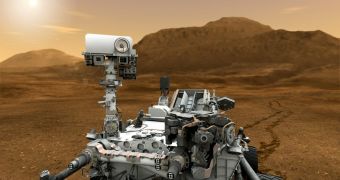Scientists with the NASA Jet Propulsion Laboratory (JPL), in Pasadena, California, say that the Mars Science Laboratory (MSL) rover Curiosity has finally exited a safe mode state it entered on November 7, following a warm reset of its main computers. The vehicle has now resumed normal operations, the team says.
The unexpected software reboot, called a reset, occurred while mission controllers were uploading new software into the rover's memory banks. JPL scientists say that something went wrong during the uplink, so safety protocols were triggered on the rover, and its computers restarted.
While Curiosity remained in safe mode, engineering teams on the ground developed all possible scenarios, and attempted to find the source of the error. Software analysts found that an error in the rover's software resulted in a glitch that affected a catalog file.
This occurred late last week, as Curiosity was relaying data to the NASA Mars Reconnaissance Orbiter (MRO), which was flying high above the planet's surface. The MRO acts as a relay between the rover and NASA ground antennas, since it has direct access to solar power.
Curiosity sent confirmation that it had exited the safe mode, and resumed nominal surface operations mode, on Sunday, November 10. The rover returned to normal engineering operations yesterday, November 12, and resumed science operations today.
“We returned to normal engineering operations. We are well into planning the next several days of surface operations and expect to resume our drive to Mount Sharp this week,” says JPL software and systems engineer, Rajeev Joshi.
The JPL group uplinked the necessary commands to take Curiosity out of its safe mode early on Sunday. The rover now operates under a new version of its original flight software, which will most likely protect it against similar occurrences in the future.
Curiosity launched towards Mars on November 26, 2011, aboard an Atlas V heavy-lift rocket. Takeoff occurred from Launch Pad 41 at the USAF Cape Canaveral Air Force Station, in Florida.
Weighing nearly a ton, and boasting the dimensions of a Mini Cooper, the rover is distinguished from any other robot to roam the surface of the Red Planet through the fact that it is powered by a radioisotope thermoelectric generator (RTG).

 14 DAY TRIAL //
14 DAY TRIAL //